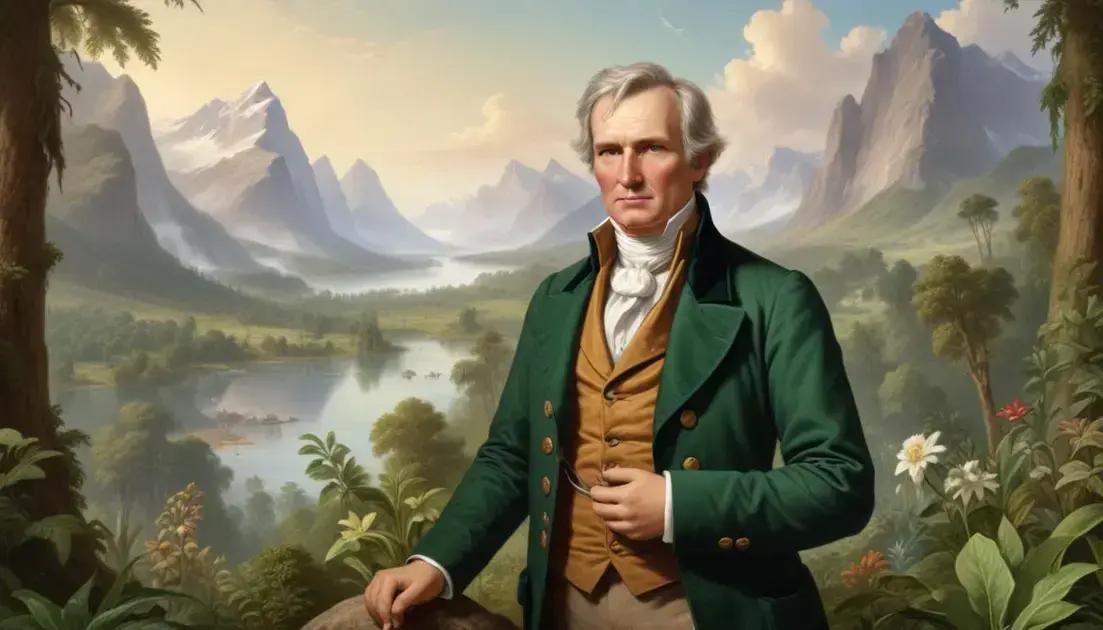
Humboldt: Science, Nature and the Map of Life
Alexander von Humboldt’s legacy significantly advanced our understanding of science and nature. He emphasized the interconnectedness of ecosystems and inspired modern environmental thought. By combining disciplines like biology and geography, Humboldt’s work laid the groundwork for future research, influencing conservation efforts and promoting sustainability. His ideas resonate today, reminding us of the importance of protecting our planet for future generations.
Have you ever wondered how the amazing discoveries of Humboldt continue to shape our understanding of nature today? Join me as we uncover the interconnectedness of science, exploration, and the living Earth!
Introduction to Humboldt’s life and work
Alexander von Humboldt was a curious explorer and a talented scientist. He lived from 1769 to 1859 and traveled to many places around the world. Humboldt’s amazing journeys took him to places like South America, where he studied mountains, rivers, and plants. He was one of the first people to understand how everything in nature is connected.
His Method of Observation
Humboldt used careful observation to learn about the natural world. He made notes and sketches of everything he saw. He wrote many books, sharing his adventures and discoveries with others. His work inspired many scientists after him.
Important Contributions
One of Humboldt’s key ideas was that the environment affects living things. He showed this through his studies of climate and geography. He also introduced the concept of ecological zones, which helps us understand different habitats today.
Influence on Science and Society
Humboldt’s ideas changed how people thought about nature and science. He combined different fields like geography, biology, and philosophy. His work paved the way for future scientists like Charles Darwin.
People today remember Humboldt not just for his discoveries but also for his belief in the importance of nature. He taught us that understanding the environment is crucial for our planet’s future.
How Humboldt integrated science and nature
Alexander von Humboldt was a pioneer in connecting science and nature. He believed that everything in the environment is linked together. Humboldt traveled the world, studying plants, animals, and landscapes. He looked at how different elements work together in ecosystems.
His Approach to Study
Humboldt used detailed observations during his travels. He measured climate, altitude, and geography. This helped him see how these factors affect living things. He showed that even small changes can impact ecosystems significantly.
Mapping Nature
Humboldt created maps based on his research. His maps detailed plant zones and climatic regions. This was revolutionary because it visualized how nature functions across different areas. He showed that plants, for instance, grow better in certain climates.
Understand the Interconnections
Humboldt’s work revealed the connections between nature and various sciences. He inspired scientists to study ecology and environmental science. His ideas encourage us to think about how nature and human actions are related.
By blending geography and biology, Humboldt changed how we view the natural world. His contributions still guide scientists and environmentalists today.
Impact on modern science and exploration
Alexander von Humboldt made a big impact on modern science and exploration. His ideas shaped how scientists study the Earth and its systems. By connecting different sciences like geology, biology, and geography, he opened new paths for exploration.
Influencing Future Scientists
Many famous scientists, including Charles Darwin, were inspired by Humboldt. They followed his example of detailed observation in nature. Humboldt’s work encourages scientists to think critically and explore their environments.
Understanding Ecosystems
Humboldt’s research helped us understand ecosystems better. He showed that all elements of nature work together. His studies highlighted the importance of preserving habitats for future generations.
Mapping and Data Collection
His innovative methods in mapping and data collection are still used today. Humboldt created visual maps that detailed climate and biomes. These maps paved the way for modern geographic and environmental studies.
Humboldt’s legacy reminds us how exploration and science are connected. His work has influenced how we view nature and inspired countless adventures.
Humboldt’s legacy in environmental thought
Alexander von Humboldt’s work laid the foundation for modern environmental thought. He taught us the importance of nature and its connection to human life. His ideas emphasize how our actions impact the environment.
Recognizing Interconnections
Humboldt showed that all parts of nature are linked. He believed that understanding these connections is vital for protecting our planet. His view encourages us to consider how everything from climate to plants affects each other.
Inspiring Conservation
His lessons have inspired many conservationists and environmentalists. They follow his belief that we must preserve nature for future generations. Without his work, modern environmental movements might not exist.
Promoting Sustainability
Humboldt’s ideas push us to think about sustainability. He believed that humans should live in harmony with nature. This mindset encourages us to make decisions that help the Earth.
Today, his legacy continues to motivate people worldwide. We remember Humboldt not just for his discoveries, but for his passion for nature.
Conclusion
In conclusion, Alexander von Humboldt’s contributions to science and our understanding of nature are invaluable. His work showed us how everything is connected in the environment. By recognizing these links, we can better appreciate the importance of preserving our planet.
Humboldt’s legacy inspires many people today to care for the Earth. His ideas on sustainability encourage us to think about how we interact with nature. As we face environmental challenges, we must remember his teachings.
By following Humboldt’s example, we can work towards a healthier and more sustainable future. Let’s continue to explore and protect our natural world, ensuring its beauty and resources for generations to come.


